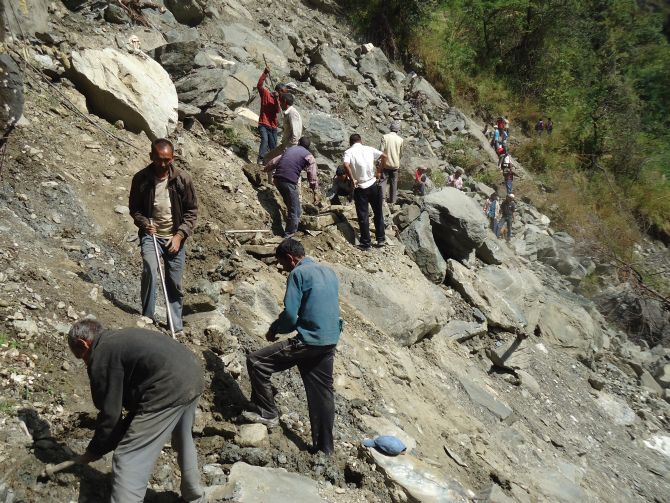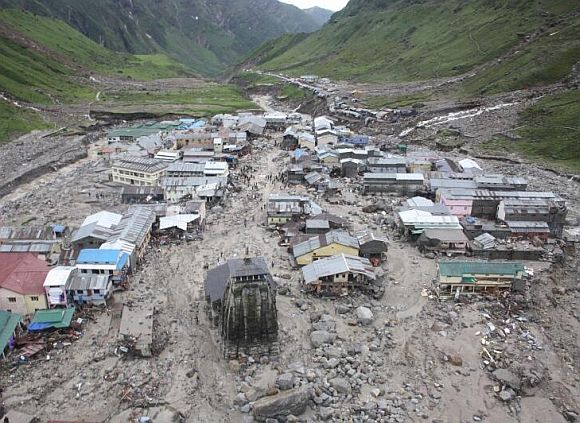Upasna Pandey
One year since the flash floods, there are serious concerns over poor infrastructure, environment and survival that continue to haunt people. Upasna Pandey reports
The monsoon may come as a big relief from the scorching heat to many of us but for the thousands of families whose lives were ravaged by the flash floods of June 16-17 last year in Uttrakhand, the sky is overcast with clouds of devastation and uncertainty.
The state government claims to have made progress in redevelopment work, which finds validation in the opening of the ‘char dham yatra’ (covering Kedarnath, Badrinath, Yamunotri and Gangotri) this year. But there are voices of alarm and foreboding as locals and NGOs point to the sluggish and shoddy restoration work done so far.
One year since the floods, there are serious concerns over poor infrastructure, the environment, people and survival issues that continue to haunt people.
“The focus has only been on making the yatra route functional. All other areas in the state that have been damaged continue to be neglected by the state government. Clearly, no lessons have been learnt from the disaster,” said Dr Ravi Chopra, director, People’s Science Institute, Dehradun, a public interest research and development organisation that has been working in innovation in water resource management, environmental quality monitoring and disaster mitigation and responses.
He said there continues to be clear apathy towards sustainable hydro power development and projects with adverse biodiversity impact need to be shut down. “The government can identify ways to improve the performance of existing 92 hydro projects and ensure that projects that are under construction are created properly, taking care of the biodiversity issues,” he said.
Chopra feels the biodiversity and ecological sensitivity of the hill state is being neglected in most of the key developmental projects.
...
NGO 'dignifies relief' to help rebuild Uttarakhand
Image: The local community is being involved in repair and rebuilding infrastructureUpasna Pandey
Government apathy notwithstanding, a lot of notable work is being done to get life back on track by some non profit organisations.
The local community is being involved in repair and rebuilding of infrastructure like roads, bridges, schools and creating other essential community spaces. Initiatives like `Cloth for Work’ by Goonj, a non profit organisation, work extensively in the reuse of urban material for rural development as a resource.
Over 8,800 people from several villages have received relief material under the initiatives. Under this programme, over 100 people from Agoda, Dhasda and Dandalka (Uttarkashi) repaired a 5 km stretch of road. Goonj alone has reached out to over 13,000 families with comprehensive winter kits to help prepare them for the harsh winter.
“The first phase of the relief disbursement campaign ‘Raahat’ was initiated along with local partners to ensure timely delivery of relief material to those affected by the floods. We have since then moved into the next phase of dignifying relief, through the ‘Cloth for Work’ programme,” said Anshu Gupta, Founder Director, Goonj.
“There are many neglected communities apart from those directly hit by the calamity last year. There are thousands of migrant labourers who live by the roadsides, Nepali porters who are critical to transportation in the hill state, disabled people and children. Of course, one of the largest and most severely affected sections is women, who are bearing the long term brunt of the devastation,” said Anshu.
...
NGO 'dignifies relief' to help rebuild Uttarakhand
Image: The widespread damage in Kedarnath caused by flash floods in 2013Photographs: ANI_News/twitter Upasna Pandey
Focus on children has translated into support for school repair work, providing over 1,400 school kits to children in village schools, disbursement of over 8,500 pair of school shoes, setting up recreation and aanganwadis, setting up libraries and study centres across villages.
“There is a need to focus on improving hygiene and overall living conditions for women. Goonj is involved in providing toilets and is working to provide hygienic cloth sanitary pads ‘My Pad’,” said Anshu. The relief measures apart, people are being supported in their moments of joy. Marriage kits, which include, ration, utensils, and in some cases bridal wear among other essentials are being disbursed to support over 200 marriages across the state.
Clearly the work done so far by government agencies has been slow and insufficient. “The fear among locals is high with the arrival of the monsoons. Thousands have lost land. The government can ensure people vacate a huge stretch of valley for Tehri Dam and relocate to a safer place, but it is not serious about those affected by the calamity last year. There is hardly anything being done to identify land to relocate people who lost their homes and agricultural land,” said B Shankar Thapliyal, editor of Regional Reporter, a regional magazine in the state.
Thapliyal said the government may have spent crores in repair and rebuilding work in the last couple of months, but it has not helped boost tourism this year and there are fears that repairs done may get washed away in the rains.
The focus on investing in redevelopment, which goes beyond relief for NGOs such as Goonj, is definitely the way to go. While government promises are many, unless there is commitment to bring the state back on its feet, there may be a long dismal road ahead for the people of Uttarakhand.




article